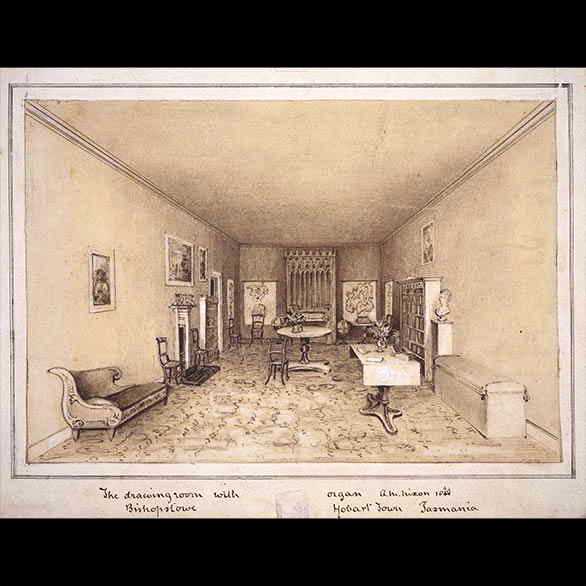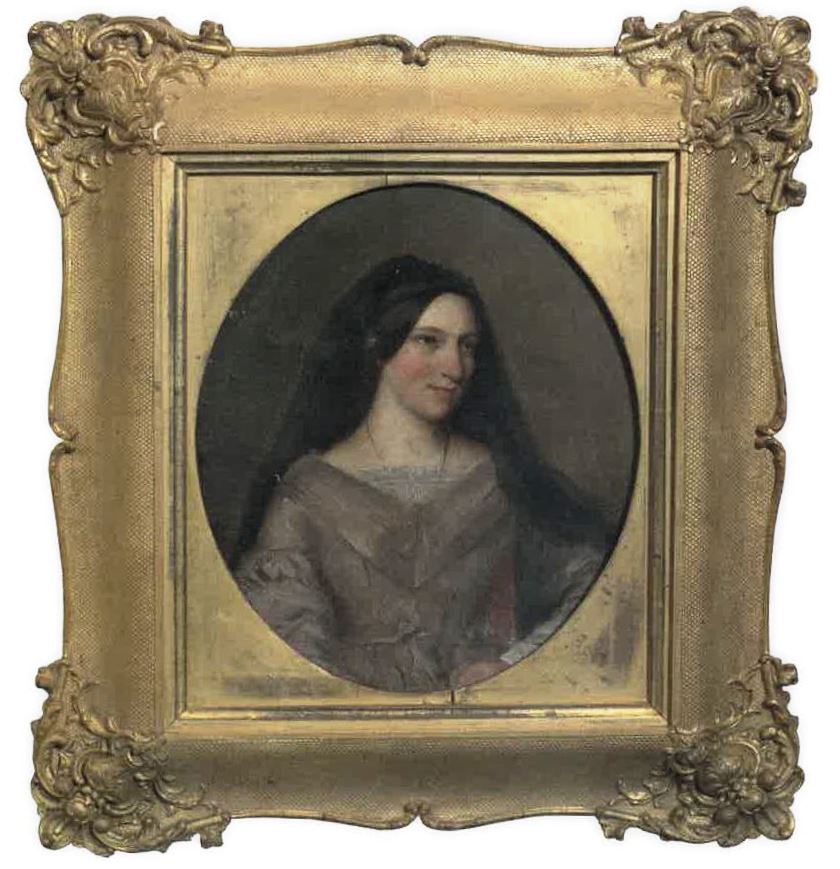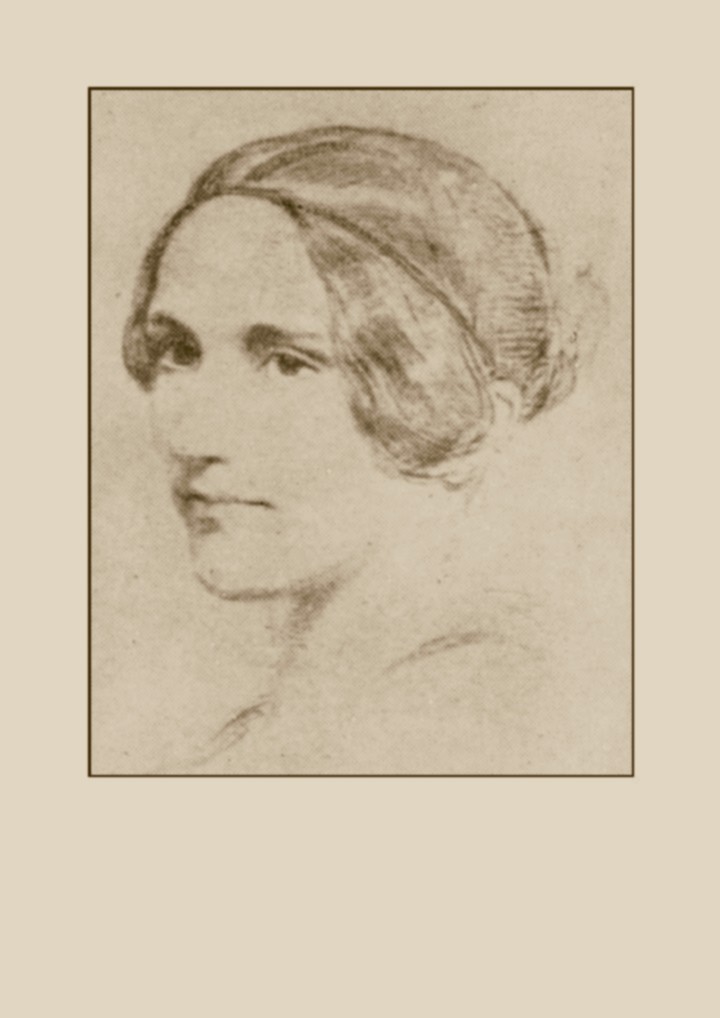Anna Maria WOODCOCK [10972]
- Born: 1 Jun 1811, Ganjam India
- Marriage (1): Rt Rev Dr Francis Russell NIXON [1203] on 5 Dec 1836 in St James Dover
- Died: 26 Nov 1868, Stresa Italy aged 57
- Buried: Stresa Italy

 General Notes: General Notes:
Anna had 6 children under her care when she sailed with Francis on the 7th March 1843 for Hobart on the s.s. Duke of Roxburgh 600 tons from Plymouth DEV. However she had 3 servants and a governess to assist. They also took the dog Leda and a cow named Duchess.
Anna was a prolific and interesting letter writer, her letters were published in a booklet "The Pioneer Bishop in VDL 1843-1863" (J Walsh & Sons. Hobart 1953)
Download; http://digital.slv.vic.gov.au/view/action/singleViewer.do?dvs=1617943082099~751&locale=en_GB&metadata_object_ratio=10&show_metadata=true&VIEWER_URL=/view/action/singleViewer.do?&preferred_usage_type=VIEW_MAIN&DELIVERY_RULE_ID=10&frameId=1&usePid1=true&usePid2=true
Off Africa a month into the voyage Anna writes to her brother of "Crossing the Line":
. . . . . Hitherto our voyage has been most favourable; indeed , our original first mate - a complete personification of Masterman Ready - says that if every voyage was like this we should be having all the old women in England coming to sea! However this may be, it has been no joke to me, for I was incessantly seasick for three weeks. We had then one week of really enjoyable weather, which was followed by the intense heat we are experiencing, when the thermometer, even before sunrise, stands at 82 in the cuddy, under an open skylight. I am rejoiced to say that we are none of us actually suffering in consequence, though the poor children are rendered sadly fretful by it. We have not yet had any calms, which must be very trying in these latitudes.
We are much pleased with our Captain, who is extremely obliging and desirous to meet our wishes. And of this we have had an instance today, for, knowing that we must go through the operation of a visit from Neptune, and not liking that it's memories should interrupt the solemnities of Passion Week, we asked that the holiday might be held today instead of waiting until we actually crossed the line; and though at three degrees North, the chief mate evidently thought this premature, our wish was complied with, and the ceremony has just been completed. A large tarpaulin filled with water was placed near the forecastle, and Mr and Mrs Neptune, in May Day attire, and well smeared with pitch and tar, and the latter dressed up in an old cotton frock of Maria's and bonnet of Nurse's, appeared in a car drawn by sailors and a huge bear, and after a colloquy with the Captain, Neptune's Clerk called over the names of all his children. Of course, all the cabin passengers paid their ransom, but our servant, Bailey, and all the sailors who had not passed the Line were shaved with a rusty piece of iron and then thrown blindfold into the bath, from whence the unfortunate victims with difficulty escaped the clutches of the bear and Neptune's satellites. . . . .
Tell dear Papa we have profited much by all his comfortable arrangements, and we are enjoying his present of Bristol water. But our Captain's fare is so excellent that, with the exception of an occasional treat of jam and honey for the children, we have not required any of our stores. The poor goat gave no milk after the first ten days, but the cow has supplied us abundantly, and we have fresh bread and rolls every day. But though I am up every morning at 5.30 and get a good bath myself, besides having to bathe all the children , I cannot get one scrap of appetite for breakfast. But all the rest of the party get on very well, and the Bishop is enjoying himself and regaining his strength and spirits, and Fanny is wonderfully better since she came on board. Our ship's medico gives great hopes of recovery; he does not think she has any organic infection of the lungs. By throwing cans of water over their heads she and all the others are enjoying all the benefits of a shower and a plunging bath. I am very much pleased with both our little maids; Nurse is really invaluable, and Maria is invariably good tempered and always looks so merry that it is quite cheering to see her. Poor Bailey has been suffering from much seasickness, and is such a downhearted creature that he can make no exertion to overcome it. I am sorry to say he has gained no goodwill for himself on board, but I hope his services when we land will make up for his lack of help during the voyage. Nothing can exceed the kindness and attention of the Archdeacon.
We hope to reach the Cape in a month from this time. It will certainly be very refreshing, though the prospect of going on board again will rather mar my enjoyment. This feeling of stickiness in one's clothes, and the want of fresh water, are to me very annoying. We have not had any serious discomforts to complain of, though, of course, just now this very hot weather, with so many children, are what you would call "trying circumstances. . . . .
We are all very cheerful, and my dearest husband full of hope and trust. Pray much for us all. A.M.N.
At Cape Town they had a very comfortable stay at Government House.
Anna describes the scene on arrival in Hobart after the 4 months passage: "Mr Bedford, the senior Chaplain, and several of the clergy, Mr Bicheno and others, all came on board to pay their respects, and intimating that it was the wish of the inhabitants to receive the Bishop publicly, we delayed our landing till 1 o'clock, when a 10 oared boat took us ashore. The clergy in gowns, and Mr Bicheno at the head of the civil authorities, and a large concourse of people, awaited us at the jetty; and most gratifying it was to observe the hearty greeting they gave their first Bishop. Mr Bicheno came forward with a short speech on the occasion, and then all the gentlemen walked with the Bishop up to Government House, where we followed in the carriage, which afterwards returned again for the children. Nothing could be kinder than our reception here - Lady Franklin kindly presses us to remain here as long as it is convenient to us."
Difficulties quickly arose accommodating the Bishop and his household, Anna turned down the inadequate house offered by the Government, they settled for a 3 year lease of a residence (326 Davey St in 1953) which required considerable renovation. However the neighbour Swanston a liberal banker proved not to the taste of the Nixon's who quit at the end of their lease buying a beautiful home "Runnymede" which Francis renamed Bishopstowe. When Francis sold in 1863, much of their property remained in the house. In the 1960's the State of Tasmania purchased the property with much of its original contents, it is now preserved for posterity by the National Trust of Australia.
It would be fair to say from Anna's writings that she shared her husbands conservative religious views and expected colonial Tasmania to march to the same tune as Victorian England.
 Research Notes: Research Notes:
Design & Art.
Australia.
Anna Maria Nixon b. c.1802
Artist (Draughtsman), Artist (Painter)
A watercolourist and sketcher who constantly sketched everywhere she went sending her works back to her family and friends as a form of correspondence.
Anna Maria Nixon nee Woodcock, was born in England in the early 1800s, daughter of Charles Woodcock. In 1836 she became the second wife of Francis Russell Nixon; they had eight children. Her husband was appointed first bishop of Tasmania and the couple arrived at Hobart Town on 18 July 1843 with their children and servants. Mrs Nixon sketched virtually everywhere she went, using her sketches as part of her prolific correspondence with her family and friends in England. She was a fine draughtsperson but underrated her own work, being always eager to defer to the bishop's superior artistic talents. After a trip from home late in 1844 she wrote to her family: 'I have been very diligent in sketching for you, but I must wait to send you the result of my poor efforts to illustrate my tour till the bishop has seen and corrected the same'.
She often sent home copies she had made of her husband's drawings rather than her own originals. For instance, she sent copies of the bishop's views of the Derwent River (Tasmania) and of the approach to Cape Town made on the voyage out in 1843, although when the Cape was sighted she noted, 'the bishop and I and Mr. Godfrey [q.v.] sketched most vigorously till about one'. Since Frederick then fell and sprained his wrist, subsequent views were by her alone: 'The Bishop and I were quite delighted with the scenery, and it was a great mortification to us both that he was not able to sketch'. Her own sketches made when approaching Hobart Town were sent home to her father in a letter of 18 July 1843, to give 'some faint idea of the beauty and grandeur of the coast. No 1 is Bruny Island with the Friar Rocks at the extreme point; and No 2 is our first view of Mount Wellington'.
A student of the picturesque (like the bishop), Nixon did not always find the Tasmanian landscape to her taste, although at times she imagined that it resembled Italy, which she loved. Nevertheless, the vast majority of her Australian works are views, many unsigned and most undated. On a trip made up country without her husband in October-November 1844, she drew numerous scenes and passed discriminating comments on the local vegetation. The Tasmanian Museum and Art Gallery holds a number of these landscape sketches, including two pencil drawings of Entally , a pencil and wash sketch Near Entally , and a pencil drawing, Ben Lomond and Valley of the Esk . Most are stylistically indistinguishable from her husband's work but an occasional example hints at a distinctive artistic personality, including an attributed watercolour and ink view dated December 1847 showing Bishop Nixon's short-lived school, Mayfield Farm, on part of the Bishopsbourne endowment, with charmingly bonneted little orphan girls in the foreground (TMAG).
The Queen Victoria Museum and Art Gallery holds Nixon's pencil sketch of the Archer property Woolmers, dated 22 December 1847, and a view of South Esk. Another watercolour is found in the album of her friend Johannah Crear (NLA). It is also extremely likely that she is the mysterious A.M . who signed several watercolours of Norfolk Island and Port Arthur and made copies of Bishop Nixon's views of the same places (DL) as well as filling a sketchbook with rough sketches of Norfolk Island (ML). Although Anna Maria normally used her full initials 'A.M.N'., Bishop Nixon referred to her as 'A.M.'.
Like other women artists, Nixon documented her domestic life. Drawings sent home to her family included a plan of their first residence in Davey Street, Hobart Town ('next door to Mr Bicheno's' [q.v.]), enclosed with a letter dated 29 September 1843: 'not very correct, I fear, as to the proportions, but perhaps the Bishop will send you a better one day'. A view of the one-roomed cottage at the bottom of their garden for their carpenter and odd-job man, Bailey, was enclosed with a letter dated 1 October 1843: 'I have made you a little sketch of this from our sitting-room window, though it can convey no idea to you of the beauty of the scene'.
Her most original and unusual work is The Drawing Room with Organ (1845, TMAG), a small pencil sketch highlighted with white which provides a rare and minutely-detailed view of a domestic interior. It has the added virtue of being accompanied by her plan and a description of each item of furniture: '1. Organ (still without a case ) ... 13. Very pretty Huon pine bookcase \endash Bailey's best job … 14. St. Sebastian [by Guido Reni, the Nixons' most prized painting] ... 15. W.H.'s sofa table covered with the blue cloth given me in 1836 by Honoria \endash on this is my Indian desk & here is my Account drawer & here I write in the morning … 26. A round Table, at wh. I am now writing Good night. 11 o'clock p.m. Jan. 2. 45'. The Nixons' art collection was described in a letter of 12 February 1845.
At first Nixon endured rather than enjoyed her Australian exile. There was 'the bitter sorrow' of parting from her family and the death of her stepdaughter Fanny (Frances Maria) on the voyage out. Her letters tell of her feelings of cultural isolation: 'No one here seems to care a straw for the arts, or even for reading, with the exception of the Macleans, where one's eyes and memory are always refreshed by views of Italy, etc., and new books.' The long separations from her husband while he travelled around his extensive diocese were a cause of loneliness for her as well as worry on her husband's behalf: 'I cannot bear that my poor husband should be deprived of the consolation he derives from his domestic ties.' As one who felt so much empathy for her husband, she was also severely affected by the political and ecclesiastical disputes in which he became involved.
Even so, as a family friend wrote, 'Mrs Nixon works as hard as [the Bishop] and makes an excellent Bishop's Lady'. As well as acting as her husband's amanuensis, she taught Sunday School classes and played the organ in St David's Cathedral, the latter being 'a great delight' to her. She learnt to enjoy the Tasmanian landscape and made many friends and established numerous ties with the colony before returning to England in 1862. Because of her husband's failing health, the Nixons moved to Vignolo near Stresa, Lake Maggiore, Italy, in 1866, but it was Anna Maria who died there on 26 November 1868. She was buried in the British Cemetery at Stresa.
Writers: Brown, Tony
Kerr, Joan
Date written:1995
Last updated:2011
Image of Anna Maria Woodcock Ref: The Pioneer Bishop of VDL by Nora E M Nixon 1953

 Other Records Other Records

1. Anna Maria Woodcock: Sketch of her drawingroom at Bishopstowe: Tasmania.
Before the arrival of photography, very few depictions of the interiors of Tasmanian colonial houses were made. This intimate and minutely-detailed sketch of a domestic interior, made by Anna Maria Nixon (1802\endash 1868) \endash the wife of Francis Russell Nixon, the first Anglican Bishop of Van Diemen 's Land \endash is rare in the history of Australian art. Showing the drawing-room at their first house in Hobart, Bishopstowe, it was also an unusual subject choice for Anna Maria, whose work was predominately landscape sketches and watercolours. Both Anna Maria and her husband were talented and prolific amateur draughtsmen. She made this drawing to accompany a letter to her mother, written late one evening two years after they had arrived on the island. Anna Maria included a numbered map and key to help describe and locate the objects in the room.
Courtesy of RWS Family Tree Ancestry - 2021

2. Anna Maria Woodcock.
Anna Maria Nixon (Sir William Boxall) undated.
Courtesy Runnymede collection Tasmania.

Anna married Rt Rev Dr Francis Russell NIXON [1203] [MRIN: 3647], son of Rev Robert NIXON [10098] and Ann RUSSELL [10099], on 5 Dec 1836 in St James Dover. (Rt Rev Dr Francis Russell NIXON [1203] was born on 1 Aug 1803 in North Cray KEN, died on 7 Apr 1879 in Lake Maggorie Italy and was buried in Stresa Italy.)
|





 General Notes:
General Notes: